A Daughter Of Mexico And Muhammad Lends Helping Hand
By Final Call News | Last updated: Oct 5, 2017 - 7:45:12 PMWhat's your opinion on this article?
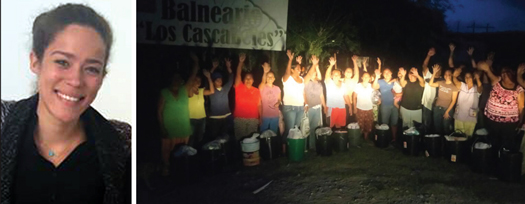
Jamilah Muhammad, (R) Community raising their hands after receiving provisions and supplies in Huixastla, Morelos, Mexico.
|
In the aftermath of two earthquakes that struck Mexico in September, rescue and relief efforts are ongoing. Jamillah Muhammad is a student and activist with a volunteer group distributing supplies in particular to indigenous communities in Mexico who were affected by the September 19 earthquake in the states of Puebla and Morelos.
At presstime, the death toll from the quake had risen to 337, with nearly 200 of the dead in Mexico City. According to some media reports, many citizens are frustrated and angry at what is being called a tepid and lackluster response from Mexican government officials in relief efforts. TelesurTV. net reported that Mexicans are organizing “citizen brigades” after the earthquake as distrust towards government grows.
Patchy provisions of aid and perceived lack of engagement by senior politicians have seen elected officials booed or even chased out of stricken neighborhoods, reported UK-based The Guardian. After the Sept. 10 earthquake survivors also complained of slow government response, reported Al Jazeera. Accusations of corruption have dogged the Mexican government for years on local and national levels, adding to a sense of distrust among citizens.
Final Call managing editor Starla Muhammad contacted Jamillah Muhammad about the current conditions in Mexico on the heels of the most recent earthquake to have her share what she and others are experiencing on the ground, their relief efforts in helping those affected by this latest disaster and the challenges the people are facing. Below are excerpts from Jamillah Muhammad’s emailed responses translated by her cousin Nura Muhammad from Spanish to English.
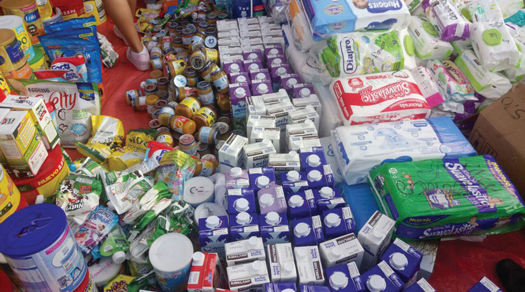
Jamillah Muhaammad received donations at Hamilton School in Cuernavaca and distributed supplies in relief efforts after the 7.5 earthquakes that hit Mexico City and Axochiapan in Morelos, Mexico, September 19. Photos: Jamillah Muhammad/Facebook
|
FINAL CALL (FC): Can you share a little bit about yourself and your background, where you grew up, etc. and explain why this particular tragedy in Mexico is so personal for you, especially for our readers who may not know the history and ties you, the Muhammad Family and the NOI (Nation of Islam) have to Mexico.
JAMILLAH MUHAMMAD (JM): I am a third year student in Veterinary School in Mexico City where I was born, but I am currently living near Cuernavaca, Morelos, which is actually where I grew up.
This tragedy is very personal to me not only because this is my country of birth and where I´m from, but also because it has always been viewed as a sacred safe house for my family. My father, Rasul Muhammad and his siblings, Ishmael, Ahmad and Madeeah Muhammad, also spent many years of their youth living here in the house of their mother, my grandmother, Mother Tynnetta Muhammad.
Cuernavaca, in particular, is very special to us because of the history of why my grandfather, the Honorable Elijah Muhammad, decided to establish part of his family in this country, which is to unite the Black and the Brown. Also, if you recall, Tepoztlán, Morelos, only 30 minutes away, is where Minister Louis Farrakhan had his vision on the Wheel.
(FC): There have been two recent earthquakes that have hit Mexico. Were you or any of your family members there for either one of them and what was that experience? Is everyone OK? Geographically, since Mexico City is probably the most well-known city in Mexico, how many miles and in what direction was this most recent quake from the capital?
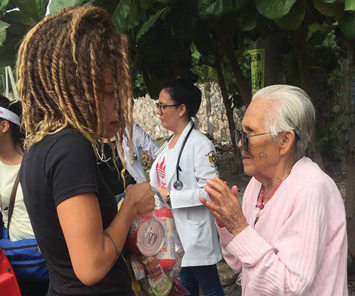
Jamillah Muhammad distributes aid to senior citizens.
|
The epicenter of one of the earthquakes was in the state that I live in, Morelos (the first in the history of this state), and hit with a magnitude of 7.5. The other was in the state of Puebla, which is approximately between 60 and 150 miles east of Morelos and an official record of the magnitude has not been made as of yet. With reference to the capital of our country, Mexico City, Morelos is 55 miles south and Puebla is 80 miles east/southeast depending on where you are exactly.
As you can see, these three states are very close to one another, they form part of the metropolitan and central area of our country. What’s surprising of this natural disaster is that it hit on the 32nd anniversary of the strongest registered earthquake in Mexico that occurred in 1985, a magnitude of 8.3 on the Richter scale.
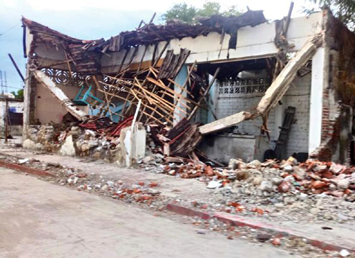
A two-story brick home was destroyed by an earthquake in Tlaquiltenango, Morelos, Mexico.
|
(FC): What city or territory do you live in and where was the recent earthquake in relationship to where you are? Describe what you are seeing and experiencing there on the ground. How are the people faring? Give us a sense of what the damage is that you are seeing.
(JM): I live in Jiutepec, Morelos, a two-hour drive from the epicenter that occurred in Axochiapán, Morelos. The damage that is seen in the rural areas surrounding the capital, Cuernavaca, is great. Part of the highway towards Guerrero (south of Morelos) is broken off, people have lost their homes because they were completely destroyed.
There are homes that suffered so much damage that they are considered uninhabitable by Civil Protection, so these people are also left without homes. Pharmacies and some supermarkets are beginning to clear out and those that aren’t increase product prices because of the high demand. They are still searching for people trapped in the debris, especially in Mexico City where a primary school fell and more than 30 children and 10 professors were trapped and since days have gone by, they want to start using machinery. Far-off indigenous communities are deprived of food and services.
It’s difficult to know with certainty the places that are most affected because many of them aren’t even on the map. The majority of areas that we’ve been to have been through word of mouth by the indigenous peoples that we know and they give us information. Tlatenchi, El Higuerón, Huixastla, Nexpa, La Era and Axochiapán (epicenter) are some of the communities that we have visited so far.
(FC): What are some of the biggest challenges and obstacles our people are facing in the aftermath of the most recent earthquake? What are the most pressing needs? What are the demographics of the areas / neighborhoods that were damaged the most?
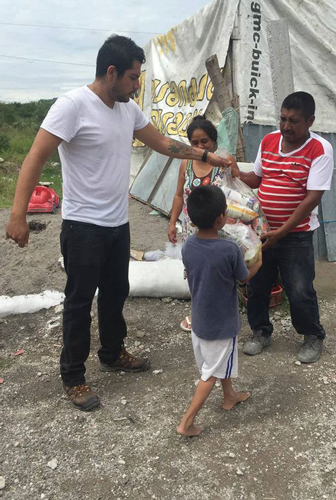
Carlos Hernandez delivers supplies to a family of three in La Era, Tlaquiltenango, Morelos, Mexico. Photos: Jamillah Muhammad/Facebook
|
(JM): Honestly, it has been chaotic. … Hence, the Mexican people have demonstrated SHOCKING solidarity and we have helped one another in an amazing way! We don’t wait for our government’s command because we don’t trust in it, we prefer to unite within and in this way, help our neighbor, and it has worked very well. The main issue has been being weary of information because there is no voice coming from leaders or officials that can tell us exactly where the most affected areas are and their specific needs.
The biggest problems that we are beginning to face in this second phase is the amount of people without homes that are now living in “temporary shelters,” which are nothing more than a canvas over streets and that’s where people and children are sleeping.
We have to wait for Civil Protection to finish evaluating every home and decide which are habitable or not and later demolish all that could continue to be a risk to the community. Months and months are estimated to begin construction of these new properties.
(FC): Talk about your relief efforts. Who are you working with (share their names and their organizations, etc., if you would like) and what have you all been doing? What areas have you gone to? What has been the response of the people? Who have been the most vulnerable in terms of needing help.
(JM): For the moment, we are mainly a group of four people: Carlos Guadarrama Hernández, María del Mar Analith Illera, Nura Muhammad Marín (my cousin), and myself. Also, we are in contact with a distribution center overseen by Iñaki here in Morelos, who has been working at the Hamilton School in Cuernavaca, and with Abraham Pérez Ballinas, who is a rescue paramedic.
Currently, we have visited different communities to distribute supplies and we are also beginning to create a stockroom at my house so that within one month, when general help from the country has ceased, we can continue to offer what we have been doing. In the meantime, we will continue to distribute and locate areas in most need.
Tlatenchi, El Higuerón, Huixastla, Nexpa, La Era and Axochiapán (epicenter) have been the communities that we have visited so far. The people have responded in different ways, some good and some not so good. There are some areas that have received such little help that they have started to rob trucks filled with supplies (fortunately that hasn’t happened to us). Distributing is always difficult because you never have enough. You have lines of people behind your car and there isn’t enough for everyone and it´s very sad and difficult to explain that you don’t have anything else to give at the moment, and people go back with empty hands waiting for the next help.
Children and babies have definitely been the most vulnerable. We want to make a specialized stockroom for children because their needs differ from those of adults and help is hardly received for them; like diapers, powdered milk, baby food or toys.
(FC): If people want to contact you or keep up to date on what is happening on the ground and what they can do to help, how can they reach you?
(JM): Email: [email protected] and Facebook: Jamillah Muhammad.
INSIDE STORIES AND REVIEWS
-
-
About Harriett ... and the Negro Hollywood Road Show
By Rabiah Muhammad, Guest Columnist » Full Story -
Skepticism greets Jay-Z, NFL talk of inspiring change
By Bryan 18X Crawford and Richard B. Muhammad The Final Call Newspaper @TheFinalCall » Full Story -
The painful problem of Black girls and suicide
By Charlene Muhammad -National Correspondent- » Full Story -
Exploitation of Innocence - Report: Perceptions, policies hurting Black girls
By Charlene Muhammad -National Correspondent- » Full Story -
Big Ballin: Big ideas fuel a father’s Big Baller Brand and brash business sense
By Bryan Crawford -Contributing Writer- » Full Story






 Click Here Stay Connected!
Click Here Stay Connected!








